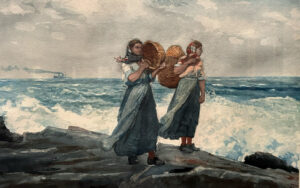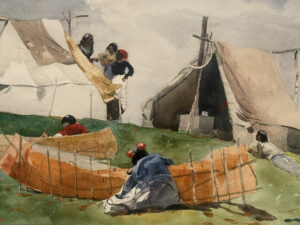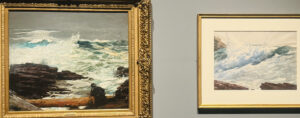
Seeing the Homer Winslow exhibit “Light and Air” feels a lot like hanging-out with Snow Birds who’ve returned home briefly for the holidays.
Boston’s Museum of Fine Arts holds the largest collection of Winslow Homer’s works. Especially sensitive to affects of light and air many of these paintings are typically archived for protection. But now, through January 19th, the MFA has fashioned galleries that cozy Homer’s work back into their old homestead~ if only for a while.
Born in Boston in 1836 the New Englander’s talent was evident in childhood. Homer grew to be an illustrator eager for a career in New York with Harper’s magazine. But, the young man’s path to success was circuitous. To capture the toll of conflict the magazine deployed the artist to Civil War battlefields.

Winslow Homer
Realities of the field expanded the visual dialogue of the talented young man. It broadened his perspective. Post war, the artist began to include emotional themes in his compositions. Children, women and animals added psychological poignancy to Homer’s articulations of the environment.

Homer’s observation of the plight of Black families in the era of Reconstruction
Color saturated galleries within the MFA highlight atmospheric qualities of places Homer spent time. Frequenting the metaphorical power of tidal flows Winslow’s canvases revisit the shores of his family’s home on Prout’s Neck, Maine often. Other features of his color-coded travel-log include the sway of Caribbean palms, Canadian fishing scenes and the dynamic beauty of the Jersey Shore.
For Homer, painting the light and air of his seasonal digs was both autobiographical, lucrative and open to challenging interpretations.
Many will feel as though visiting this exhibit is time spent with an old friend. Homer’s strokes of genus elicit a holiday-sampler of emotional vagaries; simultaneously prompting feelings of being lost-at-sea as fluidly as remembering ideals of lounging in summer’s sweet grasses.


The MFA concludes the “Light and Air” exhibit with tidal waves. They’re a must see. The painting on the right is from the beginning of Winslow Homer’s career. “Driftwood,” on the left is thought to be his last painting.

Like the holidays, the bookends are poetic. Standing alone each tells it’s own story well, but together, the dialogue speaks to the dramatic beauty of life, it’s ceaseless power and it’s unpredictable continuity. Kinda like the return of Snow Birds… ya gotta see them to catch the whole holiday drift.
Discover more from She The People News explores the world of business, culture and politics from a woman’s point of view.
Subscribe to get the latest posts sent to your email.


